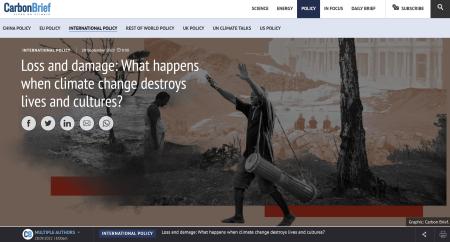ACTIONS
- Protect and safeguard cultural and natural heritage
- Learning and educational opportunities
- Cultural participation/social inclusion
- Sustainable tourism
- Support research
- Employment (recruiting, training, safety)
- Energy consumption, greenhouse gas emissions
- Waste management and reduction
- Transport (forms of, energy use)
- Commercial activities including copyright and IP
- Governance and management
- Security, disaster preparedness, risk reduction
- External partnerships and collaborations
- Case studies
- Blog post
Loss and damage: What happens when climate change destroys lives and cultures?
- D. Dunne and A. Chandrasekhar, Carbon Brief
“In this article, Carbon Brief examines the impacts of “non-economic” - or “intangible” - loss and damage in regions across the world, and asks experts to explain whether such losses can ever be accounted for.”
Avaiable in
- English
SDGs LINKAGES
The resource is most closely linked with SDG targets relating to climate action, Disaster Risk Reduction, and heritage protection, including notably SDGs 13.1 (strengthen resilience to climate impacts), 13.2 (Integrate climate change measures into national policies, strategies and planning), 13.3 (increase institutional and societal capacity for climate action), 11.4 (strengthen efforts to protect and safeguard cultural and natural heritage), 11.5 (reduce the impact of disasters), 11.B (integrated policy making for inclusion and Disaster Risk Reduction), 17.17 (cross-sector partnerships) and 17.19 (measures for sustainable development beyond GDP).
Click on the SDG Target to discover Our Collections Matter indicators
-
Our Collections Matter indicators:
- Total expenditure (public and private) per capita spent on the preservation, protection and conservation of all cultural and natural heritage, by type of heritage.
- Plans, policies and procedures in place for the safe use of collections for a variety of purposes, protecting and safeguarding both collections and those who use them.
- Plans, policies and procedures in place for the identification, safeguarding and protection of cultural and natural heritage at risk.
- Collecting programmes in place to protect, safeguard and make use of cultural and natural heritage, addressing the needs of communities and stakeholders, and ensuring that collections can be an effective resource for sustainable development.
- Number and diversity of educational, awareness-raising, research programmes, and partnerships that aim to strengthen protection of cultural and natural heritage.
-
Our Collections Matter indicators:
- Collections-based research that supports the understanding and management of disasters of all kinds.
- Plans in place for public education and awareness drawing on collections and collections-based institutions to reduce exposure and vulnerability to disasters of all kinds.
- Plans in place to ensure collections-based institutions steadily work to reduce their contributions to disaster risk, for example by reducing pollution and waste of all kinds.
- Plans in place to ensure collections-based institutions, and people related to them (including workers) are protected from economic losses as a result of disasters.
- Plans in place to provide special support/protection to poor and vulnerable people and groups in and following disasters.
-
Our Collections Matter indicators:
- Proportion of local governments that adopt and implement local disaster risk reduction strategies in line with the Sendai Framework for Disaster Risk Reduction 2015-2030a.
- Disaster Risk Reduction strategies and plans in place, in line with the Sendai Framework for Disaster Risk Reduction, to ensure collecting institutions and collections are factored into planning, and contribute effectively to Disaster Risk Reduction.
- Collections-based institutions included in local plans for social inclusion, resource use, and Disaster Risk Reduction.
-
Our Collections Matter indicators:
- Plans in place for near and longer term to withstand and actively adapt to climate-related hazards and natural disasters.
-
Our Collections Matter indicators:
- National organisations, institutions and networks relating to collections and collections-based institutions to have integrated climate change measures into policies, strategies and planning relating to collections and collections-based institutions, including funding and other resourcing considerations.
-
Our Collections Matter indicators:
- Plans in place to enhance positive contributions to addressing climate change through use of collections. Plans in place to ensure collections, collections institutions and broader society can adapt effectively to climate change.
- Plans in place for effective education and awareness raising on climate change mitigation, adaptation, impact reduction and early warning.
- Plans in place to reduce negative contributions of collections-related functions, e.g. measuring greenhouse emissions with plans and targets in place to reduce them.
-
Our Collections Matter indicators:
- Amount of United States dollars committed to public-private and civil society partnerships.
- Number and/or increase in number, and diversity of local, national and regional multi-stakeholder (public, public-private and civil society) partnerships that address the SDGs drawing on collections, or that otherwise involve collections-based organisations and institutions.
-
Our Collections Matter indicators:
- Identification and implementation of measures for sustainable development incorporating social and environmental considerations.
- Identification and implementation of both quantitative and qualitative measures of sustainable development.

